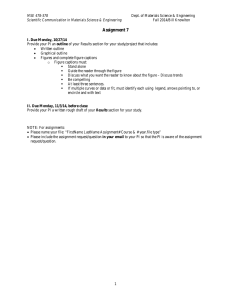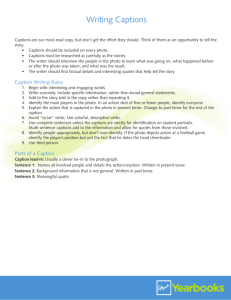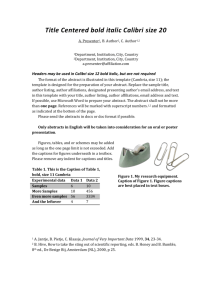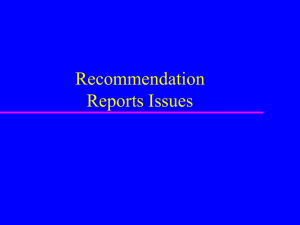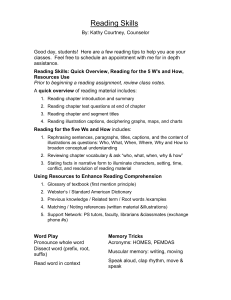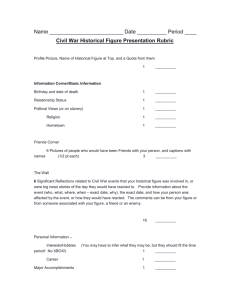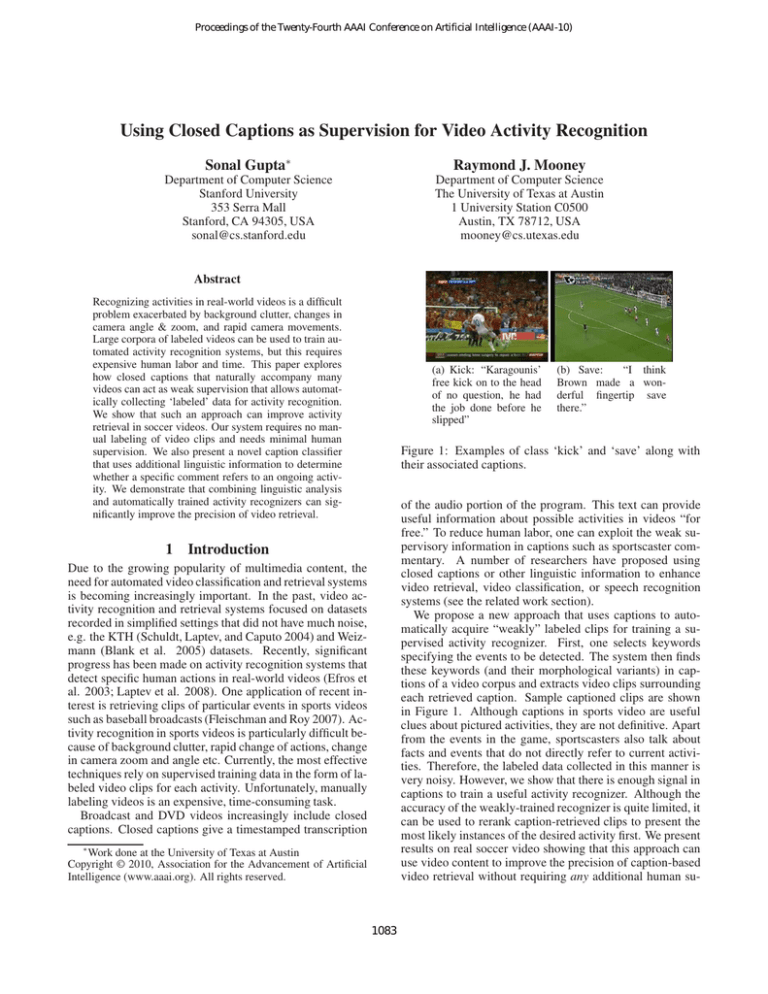
Proceedings of the Twenty-Fourth AAAI Conference on Artificial Intelligence (AAAI-10)
Using Closed Captions as Supervision for Video Activity Recognition
Sonal Gupta∗
Raymond J. Mooney
Department of Computer Science
Stanford University
353 Serra Mall
Stanford, CA 94305, USA
sonal@cs.stanford.edu
Department of Computer Science
The University of Texas at Austin
1 University Station C0500
Austin, TX 78712, USA
mooney@cs.utexas.edu
Abstract
Recognizing activities in real-world videos is a difficult
problem exacerbated by background clutter, changes in
camera angle & zoom, and rapid camera movements.
Large corpora of labeled videos can be used to train automated activity recognition systems, but this requires
expensive human labor and time. This paper explores
how closed captions that naturally accompany many
videos can act as weak supervision that allows automatically collecting ‘labeled’ data for activity recognition.
We show that such an approach can improve activity
retrieval in soccer videos. Our system requires no manual labeling of video clips and needs minimal human
supervision. We also present a novel caption classifier
that uses additional linguistic information to determine
whether a specific comment refers to an ongoing activity. We demonstrate that combining linguistic analysis
and automatically trained activity recognizers can significantly improve the precision of video retrieval.
(a) Kick: “Karagounis’
free kick on to the head
of no question, he had
the job done before he
slipped”
(b) Save:
“I think
Brown made a wonderful fingertip save
there.”
Figure 1: Examples of class ‘kick’ and ‘save’ along with
their associated captions.
of the audio portion of the program. This text can provide
useful information about possible activities in videos “for
free.” To reduce human labor, one can exploit the weak supervisory information in captions such as sportscaster commentary. A number of researchers have proposed using
closed captions or other linguistic information to enhance
video retrieval, video classification, or speech recognition
systems (see the related work section).
We propose a new approach that uses captions to automatically acquire “weakly” labeled clips for training a supervised activity recognizer. First, one selects keywords
specifying the events to be detected. The system then finds
these keywords (and their morphological variants) in captions of a video corpus and extracts video clips surrounding
each retrieved caption. Sample captioned clips are shown
in Figure 1. Although captions in sports video are useful
clues about pictured activities, they are not definitive. Apart
from the events in the game, sportscasters also talk about
facts and events that do not directly refer to current activities. Therefore, the labeled data collected in this manner is
very noisy. However, we show that there is enough signal in
captions to train a useful activity recognizer. Although the
accuracy of the weakly-trained recognizer is quite limited, it
can be used to rerank caption-retrieved clips to present the
most likely instances of the desired activity first. We present
results on real soccer video showing that this approach can
use video content to improve the precision of caption-based
video retrieval without requiring any additional human su-
1 Introduction
Due to the growing popularity of multimedia content, the
need for automated video classification and retrieval systems
is becoming increasingly important. In the past, video activity recognition and retrieval systems focused on datasets
recorded in simplified settings that did not have much noise,
e.g. the KTH (Schuldt, Laptev, and Caputo 2004) and Weizmann (Blank et al. 2005) datasets. Recently, significant
progress has been made on activity recognition systems that
detect specific human actions in real-world videos (Efros et
al. 2003; Laptev et al. 2008). One application of recent interest is retrieving clips of particular events in sports videos
such as baseball broadcasts (Fleischman and Roy 2007). Activity recognition in sports videos is particularly difficult because of background clutter, rapid change of actions, change
in camera zoom and angle etc. Currently, the most effective
techniques rely on supervised training data in the form of labeled video clips for each activity. Unfortunately, manually
labeling videos is an expensive, time-consuming task.
Broadcast and DVD videos increasingly include closed
captions. Closed captions give a timestamped transcription
∗
Work done at the University of Texas at Austin
Copyright © 2010, Association for the Advancement of Artificial
Intelligence (www.aaai.org). All rights reserved.
1083
Marszalek, Laptev, and Schmid 2009). Scripts provide detail descriptions of scenes and actions (such as “John opens
the car door”), distinct from the spoken dialog. However,
these methods cannot be used for domains such as sports
videos that do not have associated scripts.
In contrast to this prior work, our approach uses words in
captions as noisy labels for training a general-purpose, stateof-the-art, supervised activity recognizer without requiring
any human labeling of video clips. In addition, our work
does not need associated scripts, which are not available for
most videos. We also present a novel caption classifier that
classifies sentences in sports commentary as referring to a
current event or not. This caption classifier is generic and
independent of the activities to be detected and only requires
humans to label a corpus of representative captions.
pervision. Our approach is scalable and can acquire a large
amount of automatically labeled data given only a sizable
corpus of captioned videos. Though we present our experiments on soccer games, the approach is generic since it does
not use any domain-specific information.
As discussed before, captions are not definitive indicators
of specific activities in a video. To further increase precision,
we also present a method that uses a word-subsequence kernel (Bunescu and Mooney 2005; Lodhi et al. 2002) to classify captions according to whether or not they actually refer
to a current event. The classifier learns phrases indicating
a description of a current event versus an extraneous comment. Training this classifier requires some human labeling
of captions; however this process is independent of the activities to be recognized and only needs to be done once for
a given domain, such as sportscasting. To demonstrate this
generality, we present experimental results showing transfer learning from soccer captions to baseball captions, when
the classifier is trained on soccer captions and only a small
number of baseball captions and tested on baseball captions.
Transfer learning aims to improve accuracy in a target domain by using knowledge previously acquired in different
but related source domains (Thrun and Pratt 1998).
Finally, we also show that combining the weakly-trained
video classifier and the caption classifier improves the precision of activity retrieval more than either approach alone.
Gupta (2009) discusses this work in detail.
3 Approach
Figure 2 presents a diagram of our overall system. We first
describe our procedure for automatically collecting labeled
clips from captioned videos. We then explain the encoding
of videos using motion descriptors and how they are used to
train a video classifier. Next, we describe our caption classifier, and finally we explain the overall system for retrieving
and ranking relevant clips.
2 Related Work
Activity recognition in videos has attracted significant attention in recent years (Efros et al. 2003; Schuldt, Laptev, and
Caputo 2004). Activity classifiers are usually trained using
human-labeled video clips. Recently, there has been increasing interest in using related text (such as closed captions,
scripts, tags) and audio information together with visual information for various recognition and indexing tasks.
Recent work by Fleischman and Roy (2007) is the most
closely related prior research. They used both captions and
motion descriptions for baseball video to retrieve relevant
clips given a textual query. They have also presented a
method for using speech recognition on the soundtrack to
further improve retrieval (Fleischman and Roy 2008). Unlike our approach, their system performs extensive video
preprocessing to extract high-level, domain-specific video
features, like “pitching scene” and “outfield”. Training these
high-level feature extractors for preprocessing videos required collecting human-labeled video clips. Babaguchi,
Kawai, and Kitahashi (2002) present an approach to eventbased video indexing using collaborative processing of visual and closed-caption streams for sports videos. Their approach requires prior domain knowledge in the form of a
hierarchy of events and manually-constructed keyword patterns used to identify events in the closed caption stream.
Several researchers have recently proposed systems that
use information in associated scripts (available on the web)
to improve classification, object detection, scene segmentation, and video retrieval (Everingham, Sivic, and Zisserman 2006; Laptev et al. 2008; Cour et al. 2008;
Figure 2: An overview of our video retrieval system.
3.1 Automatically Acquiring Labeled Clips
Videos, particularly sports broadcasts, generally have closed
captions that can provide weak supervision about activities
in the corresponding video. We use a simple method for
extracting labeled video clips using such captions. However, captions in sports broadcasts are frequently broken into
overlapping phrases. We first reconstruct full sentences from
the stream of closed captions using a simple heuristic. Next,
we identify all closed-caption sentences in a soccer game
that contain exactly one member of a given set of activity keywords (currently, save, kick, touch, and throw). We
also match alternative verb tenses, for example save, saves,
saved, and saving. In our experiments, the number of potential clips that are rejected because their captions contained multiple query terms was about 2%, thus constraining the system to choose clips with exactly one keyword
does not significantly affect the results. We then extract a
1084
fixed-length clip around the corresponding time in the video.
In our dataset, we found that extracting 8-second clips was
sufficient to capture the activities of interest. In live sports
broadcasts, there is a significant lag between the video and
the closed captions. We correct the correspondence between
the caption timestamp and the video time to account for this
lag. Each clip is then labeled with the corresponding keyword. For example, if the caption “What a nice kick!” occurs at time 00:30:00, we extract a clip from time 00:29:56
to 00:30:04 and label it as ‘kick’. Given a large corpus of
captioned video, this approach can quickly assemble many
labeled examples with no additional human assistance.
3.2
(a) kick
(b) save
Figure 3: Sample frames from two activity classes with detected motion features.
Sentence
Beautiful pull-back.
Not only goals , but experience in the
Germans’ favor but this is the semifinal.
That is a fairly good tackle.
I think I would have saved that myself.
Turkey can be well-pleased with the way they started.
They scored in the last kick of the game against
the Czech Republic.
And Dempsey, with the first touch.
Mehmet Aur Elio, all it needed was a touch from
Semih Senturk.
Cuba earns a corner kick.
Got kicked in the face.
Motion Descriptors and Video Classification
Next, we extract visual features from each labeled video
clip and represent it as a “bag of visual words.” We use
features that describe both salient spatial changes and interesting movements. In order to capture non-constant
movements that are interesting both spatially and temporally, we use the spatio-temporal motion descriptors developed by Laptev et al. (2008). These features have been
shown to work well for human-activity recognition in realworld videos (Laptev and Perez 2007; Laptev et al. 2008;
Marszalek, Laptev, and Schmid 2009). In addition, this
approach can be used to detect activities in many domains
since it does not use any domain-specific features or prior
domain knowledge.
First, a set of interest points are extracted from a video
clip. At each interest point, we extract a HoG (Histograms of
oriented Gradients) feature and a HoF (Histograms of optical Flow) feature computed on the 3D video space-time volume. The patch is partitioned into a grid with 3x3x2 spatiotemporal blocks. Four-bin HoG and five-bin HoF descriptors
are then computed for all blocks and concatenated into a 72element and 90-element descriptors, respectively. We then
concatenate these vectors to form a 162-element descriptor.
A randomly sampled set of 117,000 motion descriptors from
all video clips is then clustered using K-means(k=200) to
form a vocabulary or “visual codebook”. Finally, a video
clip is represented as a histogram over this vocabulary. The
final “bag of visual words” representing a video clip consists
of a vector of k values, where the i’th value represents the
number of motion descriptors in the video that belong to the
i’th cluster. Figure 3 shows some sample frames with detected motion features. As shown, most motion features are
detected on interesting and useful patches picturing aspects
of player activity. However, when the players are small in
size and there is significant background clutter, many interest points are also detected in the background.
We then use the labeled clip descriptors to train an activity recognizer. The activity recognizer takes a video clip
as input and classifies whether it belongs to the output action category. We tried several standard supervised classification methods from WEKA (Witten and Frank 2005),
including SVMs and bagged decision trees. We obtained
the best results with D ECORATE, an ensemble algorithm that
has been shown to perform well with small, noisy training
sets (Melville and Mooney 2003; Melville et al. 2004). The
high degree of noise in the automatically extracted supervi-
Label
1
0
1
0
0
0
1
0
1
0
Table 1: Some examples of captions with their labels in our
dataset. Label ‘1’ means that the caption is relevant to some
event in the game.
sion made D ECORATE a particularly successful method. We
use WEKA’s J48 decision trees as the base classifier for both
D ECORATE and bagging. We use an RBF kernel (γ=0.01)
for SVMs since it performed the best out of several kernels
that were tested. We learned a binary classifier for each activity class, considering the automatically labeled clips for
that class as positive examples and clips that belong to other
classes as negative examples.
3.3 Identifying Relevant Captions
Sportscaster commentaries often include sentences that are
not related to the current activities in the video. These sentences introduce noise in the automatically labeled video
clips. For example, if a caption is “They really need to win
this game to save their reputation.”, the algorithm will extract a clip corresponding to this sentence and label it as a
‘save’ instance, which is obviously a mistake. Therefore,
we also train a caption classifier that determines whether or
not a sentence actually refers to a current event in the video.
When training this classifier, we use sample caption sentences manually labeled as relevant (1) or irrelevant (0). Examples of labeled captions are shown in Table 1. We expect
the system to learn that phrases like ‘last game’, ‘needed
touch’ are irrelevant to events going on in the video, and
phrases like ‘earns kick’, ‘first touch’ are relevant.
A string subsequence kernel is particularly useful for
learning such phrases, which otherwise are not captured by
most commonly used bag-of-words text-classification meth-
1085
Query Class
kick
save
throw
touch
ods. We use an SVM string classifier that uses a subsequence kernel (Lodhi et al. 2002), which measures the number of word subsequences shared by two strings. We use
two subsequence patterns: word and Part-of-Speech (POS)
subsequences. POS tags include potentially useful information such as verb tense. Such combined lexical and syntactic subsequence kernels have been shown to be useful for
other natural-language processing tasks such as relation extraction (Bunescu and Mooney 2005). The Stanford POS
tagger (Toutanova et al. 2003) was used to obtain POS tags
for each word and we used LibSVM (Chang and Lin 2001)
to learn a probabilistic caption classifier using this kernel.
Note that the caption classifier is trained once and is independent of the number or type of activities to be recognized since it only determines whether or not the sentence
describes a current event. Also, humans labeled the captions in the training data without viewing the corresponding
video. One might expect to need to look at the corresponding video when labeling captions; but as can be seen from
the examples in Table 1, labeling captions alone is fairly unambiguous.
3.4
# Total
303
80
58
183
# Correct
120
47
26
122
% Noise
60.39
41.25
55.17
33.33
Table 2: The number of total and correct clips for each category, along with the percentage of incorrect clips.
plain our experimental methods, and finally we present the
results.
4.1 Dataset
Our primary dataset consists of 23 soccer games recorded
from live telecasts. These games include corresponding
time-stamped captions. Each game is around 1 hour and
50 minutes with an average of 1,246 caption sentences. The
difficulty and diversity of the dataset can be seen from Figure 1. There is a wide difference in camera angle and zoom
among the clips for a category, apart from activity occlusion and high background noise. Sometimes, the players
are so small that even humans have difficulty in labeling
the clips. We extracted clips for four activity keywords:
{kick, save, throw, touch}. For evaluation purposes only,
we manually labeled this data to determine the correct clips
for each class, i.e. ones that actually depict the specified
activity. The system itself never uses these gold-standard
labels.
Table 2 shows the total number of clips for each keyword,
as well as the number of correct clips and the amount of
noise in each class (percentage of clips that are not correct).
Note that the automatically labeled data extracted using captions is extremely noisy. We can see that the noise level is
particularly high for ‘kick’ and ‘throw.’ The class ‘kick’ has
the most noise, because in addition to irrelevant captions, the
word ‘kick’ has two meanings in soccer commentary: kicking the ball, and kicking a person. We consider the former
as the correct meaning for the query ‘kick’.
The caption classifier was trained using a disjoint set of
four games. Each sentence in the text commentary of these
games was manually labeled as relevant or irrelevant to the
current activity in the game. To reduce human time and effort, this labeling was performed without examining the corresponding video. All 4,368 labeled captions in this data, including 1,371 captions labeled as relevant, are used to train
the final caption classifier.
Retrieving and Ranking Videos
Given a new soccer game, our task is to retrieve video clips
that contain a particular activity and present them in ranked
order from most to least relevant. Given an activity keyword,
we first retrieve videos using the captions alone as explained
previously. As previously mentioned, we have considered
four queries: kick, save, throw and touch. For each query i,
a set of clips Si are retrieved from the game. The goal is to
rank the clips in Si so that the truly relevant clips are higher
in the ordered list of retrievals. The ranking is evaluated by
comparing it to a correct human-labeling of the clips in Si .
Note that we use human-labeled video clips only to evaluate
the quality of ranked retrievals.
One way to rank clips is to just use the automatically
trained video classifier (called V IDEO). The video classifier assigns a probability P (label|clip) to each retrieved clip
according to the confidence it has that the clip belongs to the
particular class, and the clips are ranked according to this
probability. Another way to rank the clips is to just use the
caption classifier (called C APTION). The caption classifier
assigns a probability P (relevant|clip-caption) to each clip
based on whether its corresponding caption is believed to
describe an event currently occurring in the game. The classifier is expected to assign a higher probability to relevant
clips. Since these two approaches use different information to determine relevance, we also aggregate their rankings
using a linear combination of their probability assignments
(called V IDEO +C APTION):
P (label|clip with caption) = αP (label|clip)
(1)
+(1 − α)P (relevant|clip-caption)
The value of α is determined empirically as described in
Section 4.2.
4.2 Methodology
We performed experiments using a leave-one-game-out
methodology, analogous to k-fold cross validation. In each
fold, we left out one of the 23 games for testing and used
the remaining 22 games for collecting automatically labeled
data for training the video classifier. To select the value for
α in Eq 1, in every fold, we randomly selected two games in
the training set as a hold-out set and trained on the remaining
games. We then selected the value of α that performed the
best on the held-out portion of the training data and finally
retrained on the full training set and tested on the test set.
4 Experiments
This section presents an experimental evaluation of our approach. First we describe the data we collected, next we ex-
1086
Approach
BASELINE
C APTION
V IDEO
V IDEO+C APTION
G OLD -V IDEO+C APTION
For each query (kick, save, throw, touch), we retrieve
and rank clips in the test game as explained in Section 3.4.
We measure the quality of a ranking using Mean Average
Precision (MAP), a common evaluation metric from information retrieval that averages precision (the percentage of
retrieved items that are correct) across all levels of recall
(the percentage of correct items that are retrieved) produced
using different thresholds for a given set of ranked retrievals
(Manning, Raghavan, and Schütze 2008).
We compare our approach to a simple baseline in which
the clips retrieved using a given keyword are ranked randomly (called BASELINE). We also compare our system to
an idealized version in which the video classifier is trained
using only the correct clips for each category (as determined
by the human labeling used for evaluation) as positive examples (called G OLD -V IDEO).
4.3
Table 4: MAP scores for different ranking methods.
ing relevant captions. This was evaluated using leave-onegame-out on the four games used to train the final caption
classifier. An SVM with a subsequence kernel that includes
both word and POS subsequences (WORD+POS SSK) was
79.81% accurate, compared to 79.26% for a subsequence
kernel using just word subsequences (WORD SSK), and to
a baseline of 69.02% when captions are labeled with the
majority class. An SVM with standard bag-of-words features gave an accuracy of only 69.07%, barely beating the
69.02% baseline of guessing the majority class (negative),
thereby verifying the importance of using word order and
subsequences when classifying short caption sentences. In
our video retrieval experiments, we used a WORD+POS subsequence kernel, although we would expect similar results
with just a WORD subsequence kernel.
Results
Ranking using the Video Classifier Table 3 shows MAP
scores for ranking the clips using the video classifier trained
using different learning methods. V IDEO performs ~5 perClassifier
BASELINE
V IDEO
G OLD -V IDEO
D ECORATE
65.68
70.75
67.8
Bagging
65.68
69.31
70.5
MAP
65.68
70.747
70.749
72.11
70.53
SVM
65.68
66.34
67.20
Approach
Majority Class Baseline
Bag-of-Words
Table 3: MAP scores when ranking using a video classifier.
WORD SSK
WORD + POS SSK
WORD SSK
WORD SSK
centage points better than the baseline when D ECORATE is
used, which is the best classifier due to its robustness to
noisy training data. One interesting result is that, when using D ECORATE, V IDEO even performs better than G OLD V IDEO. For Bagging and SVM, G OLD -V IDEO performs
better than V IDEO, as expected. We suspect the reason
why V IDEO performs better when using D ECORATE is because the noise in the training examples actually helps build
an even more diverse ensemble of classifiers, and thereby
prevents over-fitting the gold-standard training examples.
V IDEO with SVM performs the worst. To avoid overfitting
in SVM, we tried several values of the regularization parameter (C) and present the best results. Since bagging is also
known to be fairly robust to noise, we suspect that SVM is
overfitting the highly-noisy training data. In subsequent results, the video classifier was trained with D ECORATE since
it gave the best performance.
Training Dataset
Soccer and Baseball
Soccer and Baseball
Soccer and Baseball
Soccer and Baseball
Soccer
Baseball
Accuracy
69.23
66.39
72.07
66.69
71.97
67.59
Table 5: Classification accuracy of the caption classifier
when tested on baseball captions.
To demonstrate the generality of the caption classifier
across different sports domains, we also used it to classify
baseball captions (relevant vs. irrelevant) when trained on
soccer captions and (optionally) a small number of baseball captions. The content of these two sports commentaries are quite different since sportscasters tend to use many
game-specific words and phrases. The baseball data consists
of 985 captions from a baseball game manually labeled as
‘relevant’ or ‘irrelevant’. Table 5 shows results of transfer
learning from soccer to baseball captions. Transfer learning
is generally performed using a large out-of-domain (source)
training set and a small or empty in-domain (target) training
set. The small baseball dataset was split into training and
test using five-fold cross validation. Therefore, the training set consisted of all of the labeled soccer captions (4,368
examples) and 80% of the labeled baseball captions (788
examples). In the table, ‘Soccer and Baseball’ means both
soccer and baseball captions were used for training. ‘Soccer’ means only soccer captions (source data) were used for
training, and similarly ‘Baseball’ means only baseball captions (target data) were used. WORD SSK using both Soccer and Baseball training data performs the best, verifying
the importance of using both word order and transfer learn-
Ranking using the Caption Classifier As explained in
Section 3.4, the caption classifier can also be used to rank
results. The MAP score for ranking with the caption classifier is shown in Table 4. C APTION performs ~5 percentage
points better than the baseline, demonstrating the value of
using linguistic information to decide whether or not a caption describes an ongoing event. It is interesting to note that
V IDEO and C APTION perform almost the same, even though
the former exploits visual information while the latter uses
linguistic cues.
Caption Classifier Accuracy The caption classifier also
performs reasonably well on its specific task of identify-
1087
nature of closed-captioned video can improve the effectiveness of activity recognition and video retrieval.
ing. However, using POS tags (WORD+POS SSK), actually
hurt performance. WORD SSK using only Baseball training
data performs even worse than the baseline because there are
not enough training examples. It is interesting to note that
WORD SSK trained only on Soccer data performs better than
most other methods, even though the training set does not
contain even a single example from the baseball domain.
Acknowledgements This research author was funded by
NSF grant IIS-0712907. We would like to thank Ruchica
Behl for labeling a part of the soccer captions. We are also
thankful to Kristen Grauman and the anonymous reviewers
for their valuable comments.
Aggregating the rankings The video and caption classifiers leverage two different sources of information, visual
and linguistic, respectively. Table 4 demonstrates that combining the two sources of information (V IDEO and C AP TION ) increases the MAP score another ∼1.5 percentage
points over the individual classifiers and ∼6.5 percentage
points over the baseline. All results in Table 4 are statistically significant compared to the BASELINE according to a
one-tailed paired t-test with a 95% confidence level. The average value of α, computed using internal cross-validation
in each trial (see Section 4.2), was 0.46.
References
Babaguchi, N.; Kawai, Y.; and Kitahashi, T. 2002. Event based
indexing of broadcasted sports video by intermodal collaboration.
IEEE Transactions on Multimedia.
Blank, M.; Gorelick, L.; Shechtman, E.; Irani, M.; and Basri, R.
2005. Actions as space-time shapes. In ICCV 2005.
Bunescu, R. C., and Mooney, R. J. 2005. Subsequence kernels for
relation extraction. In NIPS 2005.
Chang, C.-C., and Lin, C.-J. 2001. LIBSVM: a library for support
vector machines.
Cour, T.; Jordan, C.; Miltsakaki, E.; and Taskar, B. 2008.
Movie/script: Alignment and parsing of video and text transcription. In ECCV 2008.
Efros, A. A.; Berg, A. C.; Mori, G.; and Malik, J. 2003. Recognizing action at a distance. In ICCV 2003.
Everingham, M.; Sivic, J.; and Zisserman, A. 2006. Hello! My
name is... Buffy – Automatic naming of characters in TV video. In
BMVC 2006.
Fleischman, M., and Roy, D. 2007. Unsupervised content-based
indexing for sports video retrieval. In Workshop on Multimedia
Information Retrieval 2007.
Fleischman, M., and Roy, D. 2008. Grounded language modeling
for automatic speech recognition of sports video. In ACL 2008:
HLT. Association for Computational Linguistics.
Gupta, S. 2009. Activity retrieval in closed captioned videos. Master’s thesis, University of Texas at Austin.
Laptev, I., and Perez, P. 2007. Retrieving actions in movies. In
ICCV 2007.
Laptev, I.; Marszalek, M.; Schmid, C.; and Rozenfeld, B. 2008.
Learning realistic human actions from movies. In CVPR 2008.
Lodhi, H.; Saunders, C.; Shawe-Taylor, J.; Cristianini, N.; and
Watkins, C. 2002. Text classification using string kernels. JMLR.
Manning, C. D.; Raghavan, P.; and Schütze, H. 2008. Introduction
to Information Retrieval. Cambridge: Cambridge University Press.
Marszalek, M.; Laptev, I.; and Schmid, C. 2009. Actions in context. In CVPR 2009.
Melville, P., and Mooney, R. J. 2003. Constructing diverse classifier ensembles using artificial training examples. In IJCAI 2003.
Melville, P.; Shah, N.; Mihalkova, L.; and Mooney, R. J. 2004. Experiments on ensembles with missing and noisy data. In Workshop
on Multi Classifier Systems.
Schuldt, C.; Laptev, I.; and Caputo, B. 2004. Recognizing human
actions: A local SVM approach. In ICPR 2004.
Thrun, S., and Pratt, L. 1998. Learning to learn: Introduction and
overview. In Learning To Learn. Kluwer Academic Publishers.
Toutanova, K.; Klein, D.; Manning, C. D.; and Singer, Y. 2003.
Feature-rich part-of-speech tagging with a cyclic dependency network. In HLT-NAACL 2003.
Witten, I. H., and Frank, E. 2005. Data Mining: Practical Machine
Learning Tools and Techniques with Java Implementations (2nd
edition). Morgan Kaufman Publishers.
5 Future Work
Exploiting the multi-modal nature of captioned videos is a
vast and little-explored area, and there are many areas ripe
for further investigation. Improving the supervised activity
recognizer is a major area for future research. A potentially
promising approach is to preprocess the video to remove
background clutter and focus on the activity of the players
on the field.
We have shown that our approach improves the precision
of a caption-based video retrieval system by reranking clips
that were retrieved using the captions alone. Improving recall would require scanning the entire video with a trained
activity recognizer in order to extract additional clips that
are not accompanied by the corresponding activity keyword.
This is a computationally expensive process and evaluating
recall requires manual labeling of the entire video; therefore,
this was left for future research.
Another promising direction is to exploit temporal relations between activities to improve the final classifier as well
as help collect more labeled data. For example, the probability of a video clip being a ‘save’ should be higher if we
know that the immediately preceding clip is a ‘kick’. Hidden Markov Models and Conditional Random Fields could
potentially be used to model such temporal relations.
6 Conclusion
This paper has demonstrated that closed captions can be
used to automatically train a video activity recognizer without requiring any manual labeling of video clips, and that
this activity recognizer can be used to improve the precision
of caption-based video retrieval. In addition, we showed
that training a classifier to identify captions that describe
current activities can improve precision even further. Additional results demonstrated that such a caption classifier
trained for soccer also generalizes to other sports domains
like baseball. Finally, the encouraging results on aggregating retrieval rankings from both video and caption classifiers
provides additional evidence that exploiting the multimodal
1088

